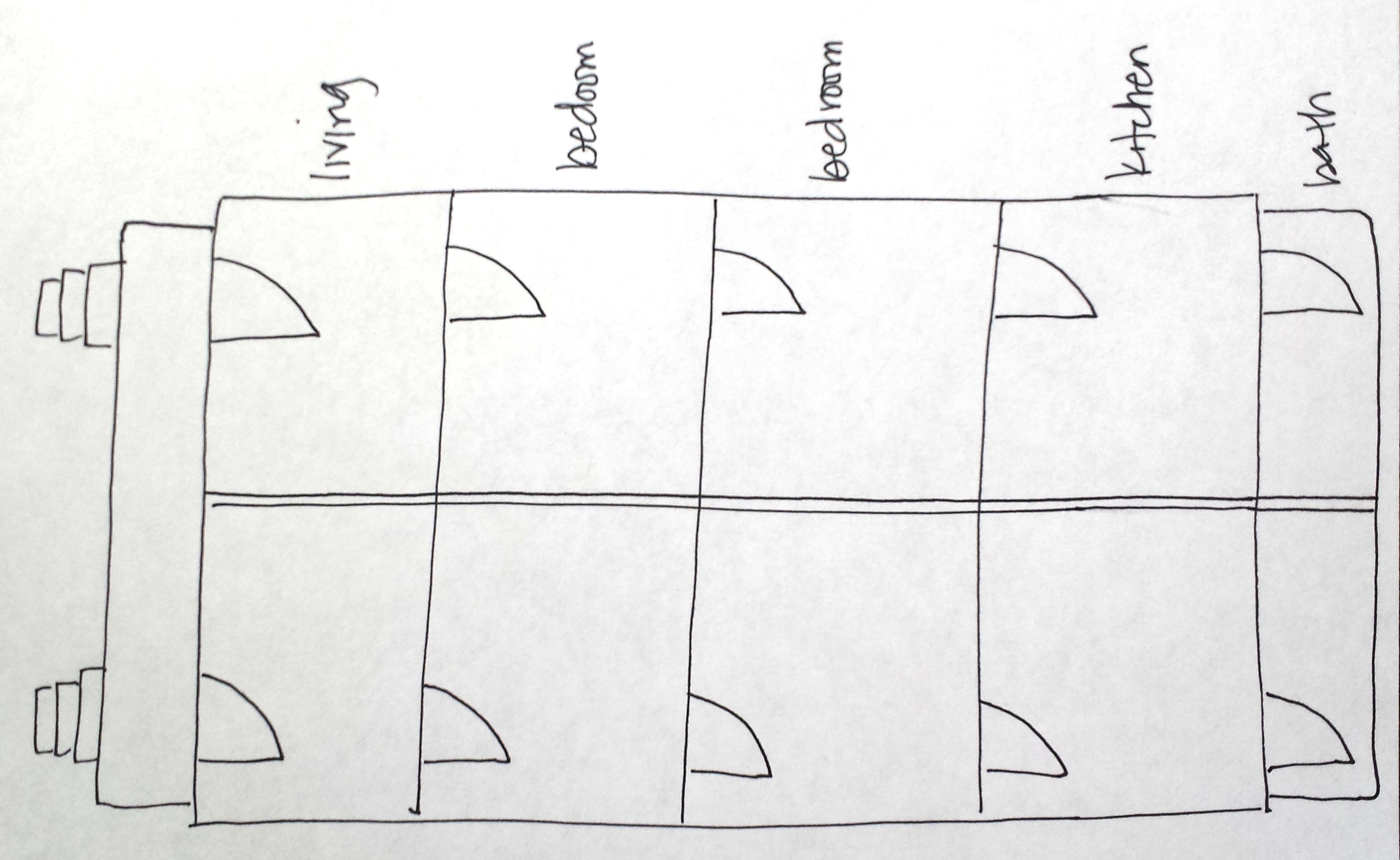 The dining rooms are coming. It’s how I know my neighborhood is becoming aspirationally middle class.
The dining rooms are coming. It’s how I know my neighborhood is becoming aspirationally middle class.
My neighborhood is filled with “shotgun” houses. Probably from West Africa, they are designed for a hot, humid climate. The homes consist of several rooms in a row. There are no hallways (and no privacy). High ceilings collect the heat and the doorways are placed in a row to encourage a breeze to blow all the way through.
Around here, more often than not, they have been built as duplexes: two long skinny houses that share a middle wall. The kitchen is usually in the back leading to an addition that houses a small bathroom. Here’s my sketch:
As the neighborhood has been gentrifying, flippers have set their sights on these double shotguns. Instead of simply refurbishing them, though, they’ve been merging them. Duplexes are becoming larger single family homes with hallways (which substantially changes the dynamic among its residents) and makes space for dining rooms. Check out the new dining room on this flip (yikes):
At NPR, Mackensie Griffin offered a quick history of dining rooms, arguing that they were unusual in the US before the late 1700s. Families didn’t generally have enough room to set one aside strictly for dining. “Rooms and tables had multiple uses,” Griffin wrote, “and families would eat in shifts, if necessary.”
Thomas Jefferson would be one of the first Americans to have a dining room table. Monticello was built in 1772, dining room included. Wealthy families followed suit and eventually the trend trickled down to the middle classes. Correspondingly, the idea that the whole family should eat dinner together became a middle class value, a hallmark of good parenting, and one that was structurally — that is, architecturally — elusive to the poor and working class.
The shotgun house we find throughout the South is an example of just how elusive. Built before closets, all the rooms in a traditional shotgun are technically multi-purpose: they can be used as living rooms, bedrooms, offices, dining rooms, storage, or whatever. In practice, though, medium to large and sometimes extended families live in these homes. Many residents would be lucky to have a dedicated living room; a dining room would be a luxury indeed.
But they’re coming anyway. The rejection of the traditional floor plan in these remodels — for being too small, insufficiently private, and un-dining-roomed — hints at a turn toward a richer sort of resident, one that demands a lifestyle modeled by Jefferson and made sacred by the American middle class.
Cross-posted at Inequality by (Interior) Design.
Lisa Wade, PhD is an Associate Professor at Tulane University. She is the author of American Hookup, a book about college sexual culture; a textbook about gender; and a forthcoming introductory text: Terrible Magnificent Sociology. You can follow her on Twitter and Instagram.


Comments 10
Dave Morris — May 31, 2016
Wow, you should come visit us in Edinburgh some time. We've taken it one step further, and you can visit any old tenement you like: They've all got washing machines and INTERNAL BATHROOMS now. Every single one of 'em.
Bloody hipsters. Where will it end, eh?
Parrot — May 31, 2016
I lived in a railroad apartment in NYC in an "up and coming" neighborhood. We added a dining space. Just saying.
mumtothree — June 3, 2016
I respectfully disagree. Whether it is a separate room or part of a larger room (living/dining, family/dining, eat-in kitchen), an eating space has long been considered an essential part of housing and life for middle- and lower-class families. The kitchen in the shot-gun house would not have been large enough for more than a very small table. It's the upper classes with their multiple cars and over-programmed kids who never even cook, much less eat, in their high-end kitchens and dining rooms.
JosephE Richmond — August 13, 2021
Infrastructure is booming everywhere. US, Canada, England, wherever you go. So why Kenya stay stay behind. there is a massive demand for 3D architecturual service here. architects services kenya required potential workers so here is platform solely designed for looking for right people who desire employment in this feild.
LindaJVinci LindaJ — September 22, 2021
I also want to share my experience. But at the right time. Then I am reading the information of the best time to post on reddit. And your article very half full any women. Thank you this article.
alfahd — February 17, 2022
Great article, thanks for sharing.
استديو تصوير نسائي
botox — September 14, 2022
Informative post
بوتاکس ایرانی مصپورت
website — September 14, 2022
I really enjoy it
ساخت سایت
Allen — July 3, 2024
Plumbing Service Group offers fast and reliable emergency plumbing services 24/7. Find Our experienced plumbers are equipped to handle all urgent issues, from burst pipes and severe leaks to clogged drains and malfunctioning water heaters. We prioritize swift response times and efficient solutions to minimize damage and restore your plumbing system quickly. Trust Plumbing Service Group for professional, dependable emergency plumbing assistance whenever you need it.